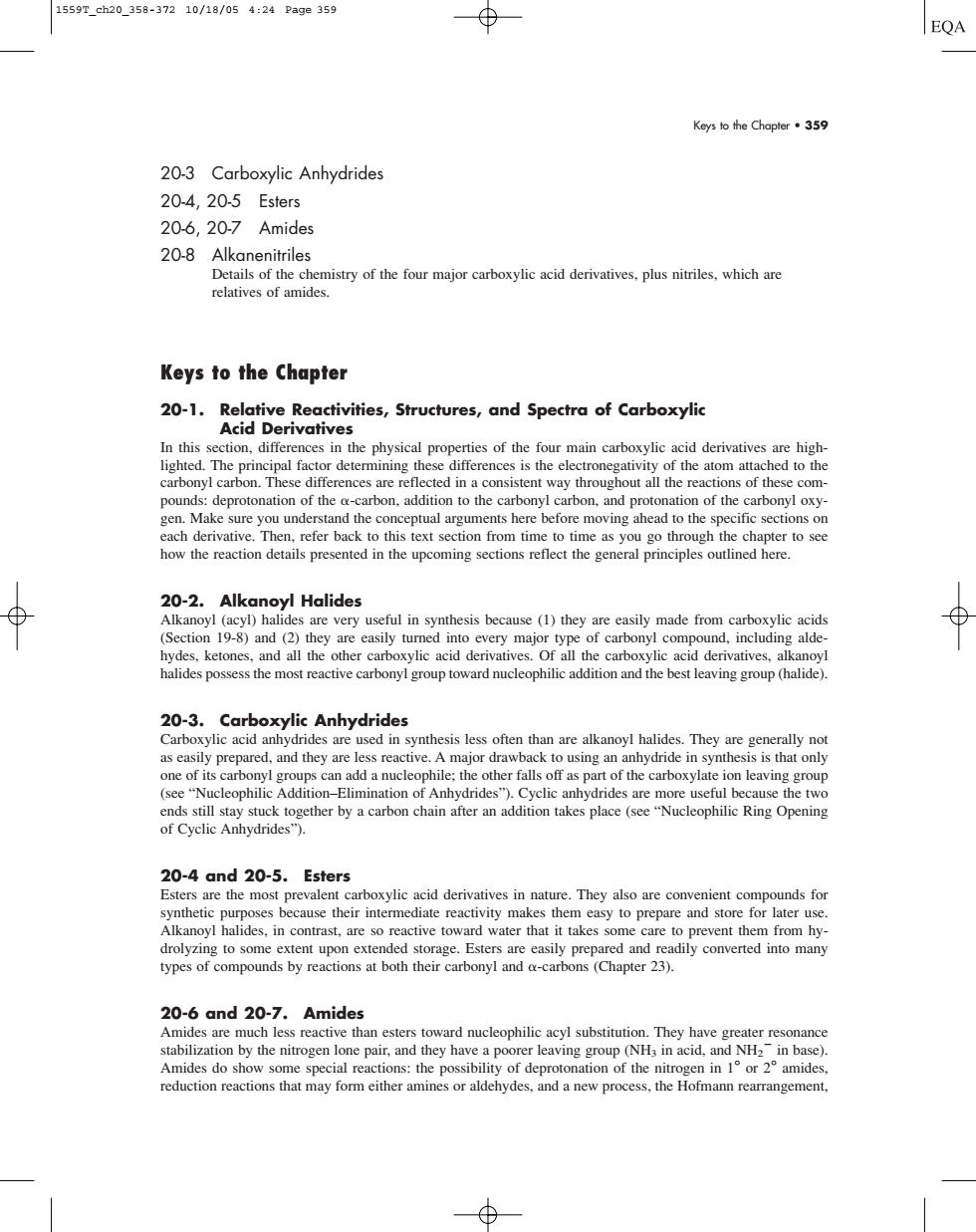正在加载图片...

1559T_ch20_358-37210/18/054:24Page359 ⊕ EQA Keys to the Chapter·359 20-3 Carboxylic Anhydrides 20-4,20-5 Esters 20-6,20-7 Amides 20-8 Alkanenitriles Details of the chemistry of the four major carboxylic acid derivatives,plus nitriles,which are relatives of amides. Keys to the Chapter 20-1.Relative Reactivities,Structures,and Spectra of Carboxylic Acid Derivatives In this section.dif physical properties of th four main carbo ns of these com arbon.addition to theca rbon,and protonanon or the 00 each derivative.Then.refer back to this text section from time to time as you go through the chapter to see how the reaction details presented in the upcoming sections reflect the general principles outlined here. l Halides Adauseful in sythesis bease they are easily made frm cabvc acd secto-)and( hey e easily turned hilic add and the st le p halide) 20-3.Carboxylic Anhydrides red and they nyl groups can add a nucleophile;the ther falls off as part of the carboxylate ion leaving group dride es a are mo use the tw of Cyclic 20-4 and 20-5. Este s nien nds for synthetic pun oses because their intermediate reactivity makes them easy to prepare and store for later use mpounds by reactions at both their anter 23) 20-6 and 20-7.Amides reduction reactions that may form either amines or al ofmann rearrangement Keys to the Chapter • 359 20-3 Carboxylic Anhydrides 20-4, 20-5 Esters 20-6, 20-7 Amides 20-8 Alkanenitriles Details of the chemistry of the four major carboxylic acid derivatives, plus nitriles, which are relatives of amides. Keys to the Chapter 20-1. Relative Reactivities, Structures, and Spectra of Carboxylic Acid Derivatives In this section, differences in the physical properties of the four main carboxylic acid derivatives are highlighted. The principal factor determining these differences is the electronegativity of the atom attached to the carbonyl carbon. These differences are reflected in a consistent way throughout all the reactions of these compounds: deprotonation of the -carbon, addition to the carbonyl carbon, and protonation of the carbonyl oxygen. Make sure you understand the conceptual arguments here before moving ahead to the specific sections on each derivative. Then, refer back to this text section from time to time as you go through the chapter to see how the reaction details presented in the upcoming sections reflect the general principles outlined here. 20-2. Alkanoyl Halides Alkanoyl (acyl) halides are very useful in synthesis because (1) they are easily made from carboxylic acids (Section 19-8) and (2) they are easily turned into every major type of carbonyl compound, including aldehydes, ketones, and all the other carboxylic acid derivatives. Of all the carboxylic acid derivatives, alkanoyl halides possess the most reactive carbonyl group toward nucleophilic addition and the best leaving group (halide). 20-3. Carboxylic Anhydrides Carboxylic acid anhydrides are used in synthesis less often than are alkanoyl halides. They are generally not as easily prepared, and they are less reactive. A major drawback to using an anhydride in synthesis is that only one of its carbonyl groups can add a nucleophile; the other falls off as part of the carboxylate ion leaving group (see “Nucleophilic Addition–Elimination of Anhydrides”). Cyclic anhydrides are more useful because the two ends still stay stuck together by a carbon chain after an addition takes place (see “Nucleophilic Ring Opening of Cyclic Anhydrides”). 20-4 and 20-5. Esters Esters are the most prevalent carboxylic acid derivatives in nature. They also are convenient compounds for synthetic purposes because their intermediate reactivity makes them easy to prepare and store for later use. Alkanoyl halides, in contrast, are so reactive toward water that it takes some care to prevent them from hydrolyzing to some extent upon extended storage. Esters are easily prepared and readily converted into many types of compounds by reactions at both their carbonyl and -carbons (Chapter 23). 20-6 and 20-7. Amides Amides are much less reactive than esters toward nucleophilic acyl substitution. They have greater resonance stabilization by the nitrogen lone pair, and they have a poorer leaving group (NH3 in acid, and NH2 in base). Amides do show some special reactions: the possibility of deprotonation of the nitrogen in 1° or 2° amides, reduction reactions that may form either amines or aldehydes, and a new process, the Hofmann rearrangement, 1559T_ch20_358-372 10/18/05 4:24 Page 359